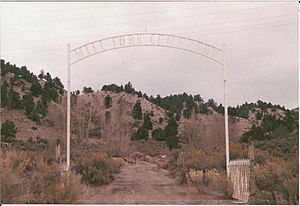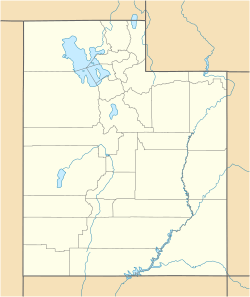Mill Fork, Utah facts for kids
Quick facts for kids
Mill Fork
|
|
|---|---|

The entrance to Mill Fork Cemetery
|
|
| Country | United States |
| State | Utah |
| County | Utah |
| Established | c. 1877 |
| Abandoned | 1930s |
| Elevation | 5,820 ft (1,774 m) |
| GNIS feature ID | 1443443 |
Mill Fork is a ghost town located in Utah County, Utah, United States. It's about 12 miles east of Thistle in Spanish Fork Canyon. The town got its name because it had many sawmills. Mill Fork was very important when the railroad was being built through the canyon. Today, you can still see the arched entrance to the small, neat Mill Fork Cemetery. It's a well-known spot on U.S. Route 6 between Spanish Fork and Price.
Contents
Mill Fork: A Railroad Town's Story
Mill Fork was once a busy place, especially because of the railroad. It played a big part in connecting different areas of Utah. Let's explore how this town grew and why it eventually became a ghost town.
Building the Railroad
In the late 1870s, the Utah and Pleasant Valley Railroad was building its tracks through Spanish Fork Canyon. This railroad later became part of the Denver and Rio Grande Western. To help with construction, the railroad set up three sawmills at Mill Fork. These sawmills cut down trees to make railroad ties, which are the wooden beams that support the railway tracks.
Life in Mill Fork
As the railroad grew, so did Mill Fork. In 1888, a large water tower and a small reservoir were built. These were important for the steam trains that needed water. Soon, a general store opened, and houses were built for railroad workers.
A special train called a "helper engine" was also kept here. A helper engine would attach to heavy trains to help them climb steep hills. At its busiest, about 250 people lived in Mill Fork.
The Charcoal Business
Besides the railroad, another important business in the canyon was making charcoal. Many people in Mill Fork worked cutting wood or operating the kilns (special ovens) to turn wood into charcoal. This charcoal was used for heating and other purposes.
The Town's Decline
Around 1890, the charcoal business closed down. After that, the general store also shut its doors. Mill Fork started to decline, and most residents moved away by 1900. A few homesteaders, who owned small farms, stayed until the 1930s.
The End of an Era
In the 1940s, trains began to use diesel locomotives instead of steam engines. Diesel trains didn't need water stops like the old steam trains. Because of this, Mill Fork was no longer needed as a water stop. The helper engine also became old-fashioned.
The Mill Fork railway station closed in 1947. By the late 1950s, the railroad removed its section house, which was a building for railroad workers. Today, very little remains of Mill Fork, except for its quiet cemetery.



